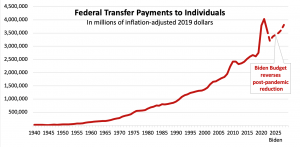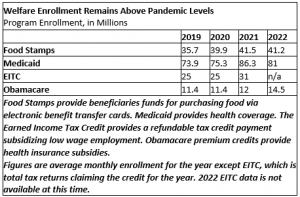April 04, 2023
A Growing Culture of Government Dependency
Growing Government Spending on Transfer Payments (Welfare, Medicaid, Medicare, Social Security, Disability Insurance, Unemployment Insurance, and other programs)
- The federal government spent a total of $4.1 trillion on transfer payments to individuals in FY 2022.
- This was 65 percent of the entire budget, absorbed 83 percent of all tax receipts, and equivalent to 16.3 percent of GDP.
- By comparison, the government spent $2.8 trillion on these programs in 2019, 62 percent of the budget, 80 percent of revenues, and 13 percent of GDP.
- Transfer payments increased 46 percent from 2019 to 2022.
- Government spending on transfer payments to individuals has vastly grown in real terms:
- In 1945, the government spent just $15.6 billion (in 2019 inflation adjusted dollars) on these programs, 1.5 percent of the budget, equal to 0.6 of GDP.
- By 1969, spending on transfer payments to individuals totaled $263 billion (in 2019 inflation adjusted dollars), 26 percent of the budget, equal to 4.8 percent of GDP.
- By 1994, transfer payments to individuals grew to 50 percent of total spending.

Growing Welfare Rolls
- More people are receiving welfare benefits today than at any time in our nation’s history.
- In 2022, 81 million people were enrolled in Medicaid (24.3 percent of the population) and 41 million received Food Stamps (12.4 percent of the population).
- This is even higher than at the height of the pandemic and government lockdowns.

- America’s welfare rolls have grown since the “War on Poverty” was declared. The percent of the population enrolled in:
- Medicaid grew from 9.3 percent in 1975 to 24.3 percent in 2022.
- Food Stamps grew from 7.9 percent in 1975 to 12.4 percent in 2022.
- The Earned Income Tax Credit (EITC) grew from 2.9 percent in 1975 to 9.3 percent in 2021.
- Supplemental Security Income (SSI) grew from 2 percent in 1975 to 2.3 percent in 2021.
- In contrast, the percent of the population on Aid to Families with Dependent Children (AFDC) shrank from 5.2 percent in 1975 to 0.9 percent on Temporary Assistance for Needy Families (TANF) in 2019 after welfare reform.
COVID Policy Changes Expand Welfare Eligibility
- Congress spent trillions creating new transfer payment programs (such as stimulus payments), expanding existing benefits (such as Food Stamp payments), and relaxing eligibility for welfare (such as preventing eligibility reviews for Medicaid).
- The new benefits (as well as many existing government benefits) are ignored or undercounted in determining eligibility for welfare programs.
- As Matt Weidinger of AEI has described the result, “a household with two unemployed adults and two young children could have collected more than $67,000 in federal pandemic payments without a penny being counted in determining its eligibility for Medicaid. That’s more than twice the federal poverty level for a family of four. Two-thirds of that amount, or nearly $47,000, would have been similarly ignored when the family applied for food stamps.”
- The Families First Coronavirus Response Act waived the Food Stamp work requirements for able-bodied adults during the public health emergency declaration.
- Since 2019, 5.5 million people have been added to the Food Stamp rolls.
- Congress also increased federal Medicaid funding and prohibited states from removing anyone from the program – even if they were ineligible.
- The Foundation for Government Accountability estimates that “90 percent of enrollment growth was a direct result of ineligible individuals,” and that “an estimated 21 million individuals that do not meet Medicaid eligibility standards remained on the program in October 2022.”
- The FY 2023 Omnibus Appropriations law ends this requirement on March 31, 2023.
- The American Rescue Plan Act and the Inflation Reduction Act expanded Obamacare subsidies by eliminating eligibility income caps (previously $106,000 for a family of four) through 2025.
- Obamacare subsidies have expanded by 3.1 million recipients (27 percent) compared to 2019.
President Biden Pushes to Expand the Cradle to Grave Dependency
- Biden budget proposes new programs and $2.6 trillion in higher entitlement spending, including:
- Child Tax Credit Expansion for Three Years – $469.9 billion
- Government Child Care – $424.3 billion
- Government Paid Family Leave – $325 billion
- Government Preschool – $200 billion
- Force States to Expand Medicaid – $200 billion
- Medicaid Home and Community-Based Care Services – $150 billion
- Expand EITC – $136.7 billion
- Expand Obamacare Subsidies – $130 billion
- Double Pell Grant – $96.1 billion
- “Free” Community College – $90 billion
- Biden has abused executive power to unilaterally increase spending on entitlement programs by more than $1 trillion, including:
- Student loan debt giveaways – $709 billion
- Increasing Food Stamp benefit levels 21 percent – $300 billion
- Expanding Medicaid eligibility – $218 billion


